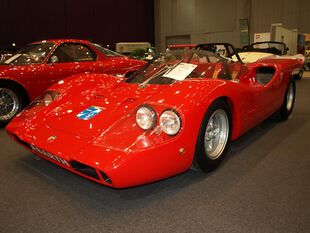Abarth 2000 Sport
Topic: Engineering
 From HandWiki - Reading time: 1 min
From HandWiki - Reading time: 1 min
| Abarth 2000 | |
|---|---|
 | |
| Overview | |
| Production | 1968-1969 |
| Designer | Abarth |
| Body and chassis | |
| Class | Group 4 Sports car[1] |
| Body style | 2-door cabriolet |
| Powertrain | |
| Engine | 4 cylinder inline, 1946 cc[2] 250 hp (190 kW)[3] |
| Transmission | 5-speed manual, rear wheel drive[2] |
| Dimensions | |
| Wheelbase | 2,085 mm (82.1 in) |
| Length | 3,850 mm (151.6 in) |
| Width | 1,780 mm (70.1 in) |
| Height | 970 mm (38.2 in) |
| |uk|Kerb|Curb}} weight | 575 kg (1,268 lb) |
Abarth 2000 Sport is an iconic Italian mid-engined racing car which won its class at the 1000 km of Monza in 1971 and finished 11th overall.[4] It was homologated for FIA Group 4 on 1 April 1969 with homologation number 252,[2] and participated in a number of car races from 1969 to 1973.[5] At least 50 cars were constructed.[6][7][8]
Popular culture
In the 1975 stop motion-animated film The Pinchcliffe Grand Prix, the racing car of Heinrich von Schnellfahrer is based on the Abarth 2000, upgraded with amongst others a larger rear wing and engine.[9]
References
- ↑ "FIAT ABARTH 2000 SPORT TIPO SE 010". https://www.fcaheritage.com/en-uk/heritage/stories/abarth-SE010-2000.
- ↑ 2.0 2.1 2.2 FIA Historic Database
- ↑ "1969 Abarth 2000 Sport Tipo SE010". https://rmsothebys.com/en/auctions/pa22/paris/lots/r0002-1969-abarth-2000-sport-tipo-se010/1168852.
- ↑ "COACHBUILD.COM - Abarth SE010 2000 Sport Spider 1969". https://www.coachbuild.com/2/index.php/marketplace/item/abarth-se010-2000-sport-spider-1969.
- ↑ Abarth 2000S group 4 (1968) - Racing Cars
- ↑ 1968 - 1969 Abarth 2000 Sport Spider Specifications - Ultimatecarpage.com
- ↑ "Abarth 2000 Sport SE". https://www.classicdriver.com/en/car/abarth/2000-sport-se/311651.
- ↑ "Abarth 2000 Sport SE". https://letocar.com/en/abarth-2000-sport-se/.
- ↑ Vokser aldri fra Flåklypa (article from Norwegian newspaper)
 |
Licensed under CC BY-SA 3.0 | Source: https://handwiki.org/wiki/Engineering:Abarth_2000_Sport5 views | Status: cached on August 09 2024 13:51:59↧ Download this article as ZWI file
 KSF
KSF